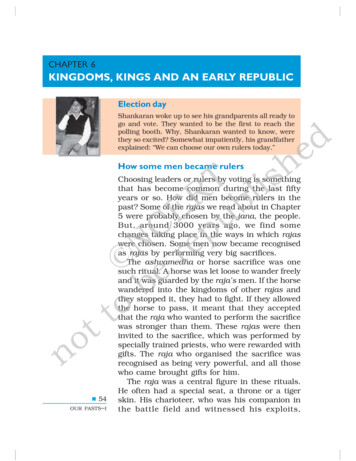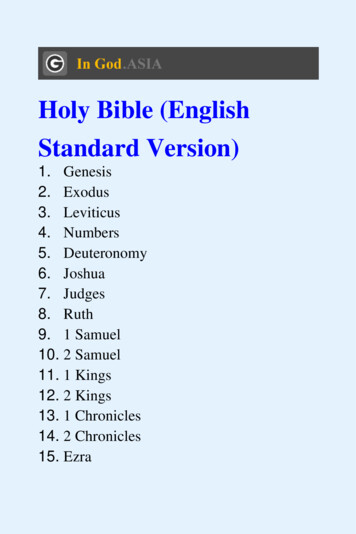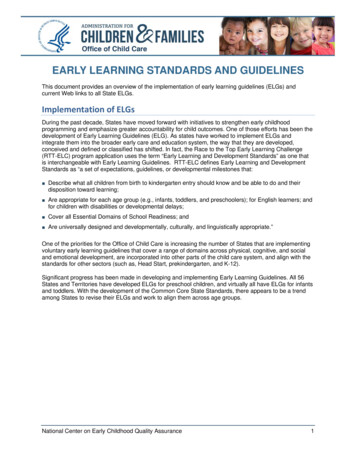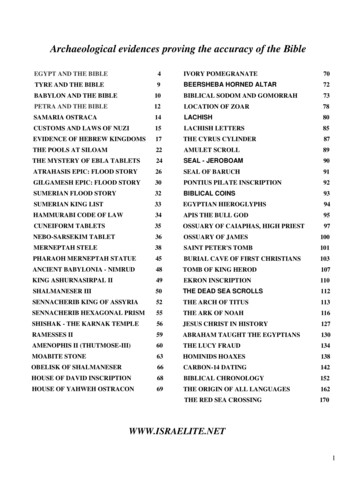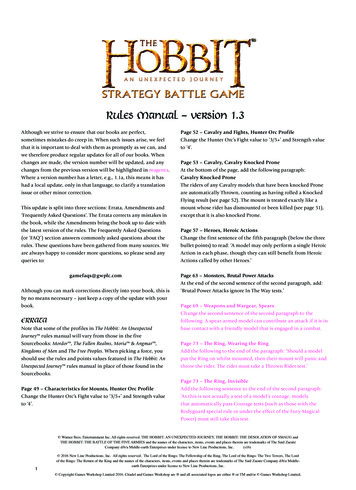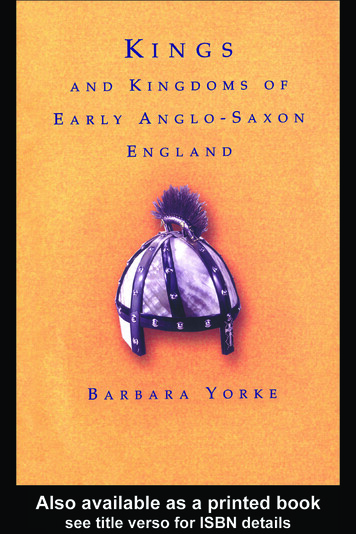
Transcription
Kings and Kingdomsof earlyAnglo-Saxon EnglandBarbara YorkeLondon and New York
To the several generations of King Alfred’s College History students who haveexplored kings and kingdoms in early Anglo-Saxon England with meFirst published 1990 by B.A.Seaby Ltd Barbara Yorke 1990Routledge is an imprint of the Taylor & Francis GroupThis edition published in the Taylor & Francis e-Library, 2003.All rights reserved. No part of this book may be reprinted or reproduced orutilised in any form or by any electronic, mechanical, or other means, nowknown or hereafter invented, including photocopying and recording, or inany information storage or retrieval system, without permission in writingfrom the publishers.British Library Cataloguing in Publication DataYorke, Barbara 1951–Kings and Kingdoms of early Anglo-Saxon England.1. England. Kings, to 1154I. Title942.010922Library of Congress Cataloguing in Publication DataA catalogue record for this book is available from the Library of CongressISBN 0-203-44730-1 Master e-book ISBNISBN 0-203-75554-5 (Adobe eReader Format)ISBN 0-415-16639-X (Print Edition)
CONTENTSForewordvList of tables and illustrationsviIINTRODUCTION: THE ORIGINS OF THE ANGLO-SAXONKINGDOMSWritten sources: BritishWritten sources: Anglo-SaxonArchaeological evidenceThe political structure of Anglo-Saxon England c. 600The nature of early Anglo-Saxon kingshipSources for the study of kings and kingdoms from theseventh to the ninth centuriesIIKENTSourcesThe origins of the kingdom of KentThe history of the kingdom of KentThe Kentish royal houseRoyal resources and governmentConclusionIIITHE EAST SAXONSSourcesThe origins of the East Saxon kingdomThe history of the East Saxon kingdom c. 600–825The East Saxon royal houseConclusionIVTHE EAST ANGLESSourcesThe origins of the East Anglian kingdomThe history of the East Anglian kingdomSources of royal 264
ivVContentsThe royal family and The royal houses of Bernicia and Deira and the originsof NorthumbriaThe early Northumbrian kings and the kingdoms ofsouthern EnglandNorthumbria and the Celtic kingdoms in the seventhcenturyNorthumbrian kingship in the eighth centuryEighth-century Northumbrian kings and the otherkingdoms of BritainNorthumbria in the ninth centuryConclusionVIMERCIASourcesThe origins of MerciaMercia in the seventh centuryMercia in the eighth centuryMercia in the ninth centuryConclusion: the evolution of the Mercian stateVIITHE WEST SAXONSSourcesThe origins of WessexThe growth of Wessex to 802The pattern of West Saxon kingship to 802The West Saxon kingdom 1117124128128130132142148154CONCLUSION: THE DEVELOPMENT OF KINGSHIPc. 600–900Kingship and overlordshipRoyal resourcesRoyal and noble familiesKing and aphy and Abbreviations196
FOREWORDThere are many excellent general surveys of Anglo-Saxon history, but their drawbackfor anyone interested in the history of one particular kingdom is that there is notusually an opportunity to treat the history of any one kingdom as a whole. This studysurveys the history of the six best-recorded Anglo-Saxon kingdoms within the periodAD 600–900: Kent, the East Saxons, the East Angles, Northumbria, Mercia andWessex. The chapters, like many of the available written sources, approach thehistories of the individual kingdoms through that of their royal families. Dynastichistory is a major concern of the book, but the intention is to go beyond narrativeaccounts of the various royal houses to try to explain issues such as strategies ofrulership, the reasons for success or failure and the dynamics of change to the office ofking. More generalized conclusions suggest themselves from the studies of individualkingdoms and these are brought together in the final chapter which examines fourmain facets in the development of kingship in the period under review: kingship andoverlordship; royal resources; royal and noble families; and king and church. The firstchapter is also a general one and deals with the difficult issue of Anglo-Saxon kingshipbefore 600 and introduces the main classes of written record.Another aim of the work is to alert the general reader to the exciting research intoearly Anglo-Saxon England which has been carried out in recent years by historiansand archaeologists, but which may only be available in specialist publications. Anywriter is, of course, dependent on the primary and secondary works which areavailable and differences in the material which has survived or the type of researchwhich has been done have helped dictate the shape of the chapters for the individualkingdoms. Readers who wish to follow up individual references will find full detailsthrough the notes and the bibliography. Notes have been primarily used for referencingsecondary works, but there are some instances in which additional commentary hasbeen provided through them. The reader is alerted to many major problems ofinterpretation through the text, but shortage of space and the nature of the book haveprevented detailed discussion of the more complex issues.Although I have been able to indicate the written works to which I have beenindebted, it is more difficult to demonstrate the immense benefit I have gained fromdiscussions with other Anglo-Saxonists. It would be impossible to name all those fromwhom at one time or another I have received advice and encouragement, but I hopethat if they read this they will know that I am grateful. My thanks go, in particular, toProfessor Frank Barlow with whom I began my study of Anglo-Saxon kingdoms formy doctoral thesis and to Dr David Kirby who very kindly read the book inmanuscript and generously made many suggestions for its improvement. I am alsomost grateful to those who provided me with photographs and captions and to asuccession of editors at Seaby’s for their patience and assistance. Finally, on the homefront, I must thank my husband Robert for without his continuing support 1 doubt ifthis book would ever have been completed.WINCHESTER 30 SEPTEMBER 1989v
LIST OF TABLES AND ILLUSTRATIONS1 Regnal list of the kings of Kent2 Genealogy of the Oiscingas kings and princes of Kent3 Female members of the Kentish royal house and theirconnections by marriage4 Regnal list of the kings of the East Saxons5 Genealogy of the East Saxon kings6 Regnal list of the kings of the East Angles7 Genealogy of the East Anglian royal house8 Regnal list of the kings of Bernicia, Deira and Northumbria ofthe sixth and seventh centuries9 Genealogy of the royal houses of Bernicia and Deira10 Regnal list of the kings of Northumbria of the eighth andninth centuries11 The rival families of eighth-century Northumbria12 Regnal list of the kings of Mercia13 Genealogy of the Mercian royal house14 The rival lineages of ninth-century Mercia15 Regnal list of the rulers of the West Saxons16 Genealogy of the West Saxon ions used in the tablesd died; k killed; m married; † died in infancy; A broken line in the tables indicatesa hypothetical link.For further information on the chronologies and family relationships of the AngloSaxon royal houses see the Handbook of British Chronology (Dumville 1986b) with whichthese tables are broadly in agreement.Figures 1–7 appear on plates between pp. 90–91 and figures 8–14 on plates betweenpp. 106–107.Fig. 1 The Benty Grange helmet.Fig. 2 The Sutton Hoo helmet.Fig. 3 The Sutton Hoo ‘sceptre’.Fig. 4 The Sutton Hoo purselid.Fig. 5 The Alfred jewel.Fig. 6 Offa’s Dyke.Fig. 7 Hamwic.Fig. 8 Cowdery’s Down.Fig. 9 Yeavering.Fig. 10 Repton Church.Fig. 11 The Repton sculpture.Fig. 12 Bradwell-on-sea, Essex: St Peter’s.Fig. 13 Brixworth, Northants: All Saints.Fig. 14 Seven coins of the early Anglo-Saxon period.Map 1 Anglo-Saxon provinces at the time of the compositionof the Tribal Hidage (? late seventh century)Map 2 Bernicia and Deira and their Celtic neighboursvi1214
Chapter OneINTRODUCTION: THE ORIGINS OF THE ANGLO-SAXONKINGDOMSThere is a sense in which the history of the early Anglo-Saxon kingdoms canbe said to have begun with the arrival of Augustine and a band of nearly fortymonks at the court of King Æthelbert of Kent in 597. Augustine and hisfollowers had been despatched by Pope Gregory the Great ‘to preach the wordof God to the English race’ and, as far as we know, their mission was the firstsustained attempt to bring Christianity to the Anglo-Saxons.1 Not surprisinglythe arrival of Augustine and his followers was an event of the utmostsignificance to Bede, whose Ecclesiastical History of the English People (completed in731) is our main narrative source for the seventh and early eighth centuries,and he began his detailed discussion of the history of the Anglo-Saxonkingdoms at this point. Bede as a monk naturally believed that the conversionof his people began a new phase in their history, but it would also be true tosay that it was only after the arrival of the Augustine mission that Bede wasable to write a detailed history of his people. For Augustine and his fellowmonks not only brought a new religion to the Anglo-Saxons; they also broughtthe arts of reading and writing.Although the arrival of the Gregorian mission clearly marked a veryimportant stage in the religious history of the Anglo-Saxons and in theproduction of written records, it is not an ideal point at which to begin aninvestigation into the history of the Anglo-Saxon kingdoms. For it is evidentthat the majority of Anglo-Saxon kingdoms were already in existence by 597and that the complex political pattern of interrelationships and amalgamationswhich Bede reveals in his Ecclesiastical History had its origins in the pre-Christianperiod. This is frustrating for the historian for it means that many vital stagesin the early growth of Anglo-Saxon kingdoms took place offstage, as it were,before the provision of adequate written records had begun. Fortunately thehistory of the country between AD 400 and 600 is not purely dependent uponwritten records and the evidence of place-names and archaeology hastransformed our appreciation of the period. As new archaeological sites areconstantly coming to light, and as much work which has already taken placehas not yet been fully written up, the full potential that the archaeologicalevidence has for the understanding of the sub-Roman period is far from beingrealized.Written sources: BritishThe settlement of the Anglo-Saxons in Britain and the origins of the Anglo1
2Kings and Kingdoms of early Anglo-Saxon EnglandSaxon kingdoms are two closely related, but not identical problems. Ournearest contemporary written source for the period of the Anglo-Saxonsettlements is the homiletic work ‘The Ruin of Britain’ (De Excidio Britanniae) inwhich a British cleric called Gildas reviews the events of the fifth century fromthe vantage point of one of the surviving British kingdoms in the western halfof Britain at a date (probably) around the middle of the sixth century.2 Gildas’subject is not so much the advent of the Anglo-Saxons, but the sins of theBritish which, to his way of thinking, were ultimately responsible for provokingthe vengeance of God in the form of Germanic and other barbarian piraticalattacks. Gildas briefly sketches a picture of Saxons being utilized by the Britishas federate soldiers in eastern England following the recall of the Romanlegions, of the federate settlements growing in size and confidence until theywere strong enough to overthrow their paymasters, and of the Saxons thenwreaking havoc on the hapless British until the famous victory of MonsBadonicus (Mount Badon) some forty-four years before the time that Gildas waswriting.3 The account is brief and lacks dates, and is clearly inaccurate oncertain points such as assigning the building of the Hadrian and AntonineWalls to the fourth century. Gildas was relying on oral tradition rather thanwritten records and gives an impressionistic version of events that had takenplace before his birth; however, his is the only narrative we possess for theperiod of the Anglo-Saxon settlements and so it has provided the frameworkfor a discussion of the events of the sub-Roman period from the time of Bedeonwards.Although Gildas is best known for his information on the adventus of theAnglo-Saxons, his testimony is equally important for the nature of Britishsociety in the sixth century when he was writing from personal knowledge.The castigation of this society was the real focus of Gildas’ polemic andamong his principal targets were British kings ruling in south-westernEngland and Wales.4 These areas had been part of the Roman province ofBritain, but by the sixth century little that was characteristic of the lateRoman world apparently survived except adherence to Christianity (whichGildas evidently saw as rather half-hearted). Control had passed to kingswhom Gildas characterized as ‘tyrants’ and whose basis of power was theirarmed followings. It was a society in which violence was endemic. Gildas’brief sketch of British society in the west in the sixth century is broadly inaccordance with what can be discerned from later charters, saints’ Lives andannals from Wales.5 There would also appear to have been many points ofsimilarity between the exercise of royal power in Wales and in the Celtic areasof northern Britain,6 and the ruler and his warband are portrayed in rather adifferent, heroic, light in the poem Gododdin which recounts a disastrous raidmade from the kingdom of the Gododdin (in south-east Scotland) against theDeiran centre of Catterick.7The tradition of events in the fifth century which Gildas reports seems tohave been, in summary, that in part of eastern Britain those on whom powerhad devolved following the withdrawal of the Roman legions attempted to
The Origins of the Anglo-saxon Kingdoms3provide for their defence by hiring Germanic forces who eventually seizedpower from them, whereas in the western half of Britain comparablecircumstances saw the rise of native warlords who filled the power vacuum andestablished kingdoms within former Roman civitates.Written sources: Anglo-SaxonWhen Bede wrote his Ecclesiastical History in 731 he used earlier narrativesources to provide some history of Britain before the advent of the Gregorianmission and took the basis of his account of the Anglo-Saxon settlement fromGildas’ work.8 Gildas did not provide any identification of the Saxon leaderswho commanded the federates ‘in the eastern part of the island’, but Bedeinterpolated a passage in which he identified the leaders as two brothers,Hengist and Horsa, who were claimed to be the founders of the royal house ofKent.9 The information presumably came from Abbot Albinus of Canterburywho was Bede’s chief Kentish informant.10 More detailed versions of theactivities of Hengist and Horsa appear in the Anglo-Saxon Chronicle and in the‘Kentish Chronicles’ included in the Historia Brittonum, a British compilationwritten in 829–30 and attributed to Nennius.11 The Anglo-Saxon Chronicle alsocontains accounts of the arrival of Cerdic and Cynric, Stuf and Wihtgar andÆlle and his sons, the founders respectively of the kingdoms of the WestSaxons, the Isle of Wight and the South Saxons.12 These founding fathersarrived off Britain with a few ships and, after battling against British leaders forsome years, established their kingdoms. Briefer notices for Northumbria andthe Jutes of mainland Hampshire seem to conform to a similar pattern ofevents. By the eighth and ninth centuries it had apparently becomeconventional to depict the founders of royal houses arriving fresh from theContinent to set up their kingdoms. There seems to have been a standard‘origin tradition’ which was utilized to explain the establishment of the variousAnglo-Saxon royal houses; even Gildas’ account may have been influenced bysuch a convention.13 It would be unwise to assume that these foundation storiesare historically valid.Bede introduced his information about Hengist and Horsa with the phrase‘they are said ’ (perhibentur), a formula he used elsewhere in his history whenhe was drawing on unverifiable oral tradition. Bede’s comment suggests thatwe should use the information on the Kentish adventus with caution andcertainly when one looks at the fuller narratives of the foundation of Kentand at the activities of Cerdic and Cynric one can see further reasons forquestioning their historical validity. One must remember that these sourcesare not contemporary with the events they describe, but written some three tofour hundred years later. They contain a number of features which can befound in foundation legends throughout the Indo-European world. 14Particularly suspicious are the pairs of founding kinsmen with alliteratingnames, who recall the twin deities of the pagan Germanic world, and othercharacters whom the founders defeat or meet whose names seem to bederived from place-names. Thus the Chronicle describes a victory in 508 by
4Kings and Kingdoms of early Anglo-Saxon EnglandCerdic and Cynric over a British king called Natanleod after whom, it is said,the district Natanleaga was named. In fact the name of this rather marshy areaof Hampshire derives from the OE word naet ‘wet’ and it would appear thatthe name of a completely fictitious king has been taken from the place ratherthan the other way around.15 There are many other examples of this type, andthe Kentish foundation legends also contain other traditional story-tellingmotifs such as ‘the night of the long knives’ in which the Saxons lured manyBritish nobles to their death by means of a ruse also found in the legends ofthe Greeks, Old Saxons and Vikings.The chronologies of these foundation accounts are also suspect. Gildasprovided no actual date for the Anglo-Saxon adventus, but Bede interpreted hiswords to mean that the first invitation to the federates was given between 449and 455.16 The arrival of Cerdic and Cynric is said to have occurred in 494or 495, but it can be demonstrated that the chronology of the earliest WestSaxon kings was artificially revised and traces of the rather clumsy revisionremain in the repetitive entries within the Anglo-Saxon Chronicle. 17 DavidDumville has argued that other versions of the West Saxon regnal list implythat the reign of Cerdic was originally dated to 538–54 which (following thetime sequence of the Chronicle) would place the arrival of Cerdic and Cynric in532. 18 The detailed critiques which have been made of the foundationaccounts in recent years make it difficult to use them with any confidence toreconstruct the early histories of their kingdoms in the way which earliergenerations of historians felt able to do. Even if there was a genuine core tothe stories of Cerdic and Hengist it is impossible to separate it out from thelater reworkings which the stories have evidently received. The accounts asthey survive show how later Anglo-Saxons wanted to see the foundation oftheir kingdoms, rather than what actually occurred.Cerdic was the founder king of the West Saxon dynasty from whom allsubsequent West Saxon kings claimed descent. We know for a number ofother kingdoms who the founders of their royal houses were believed to beand what their positions in regnal lists and genealogies were. As in the case ofCerdic (if we accept the revised date for his reign), these other examplessuggest a sixth-century date for the formation of kingdoms. Bede, forinstance, reveals that the kings of the East Angles were known as Wuffingasafter Wuffa, the grandfather of King Rædwald.19 As Rædwald died in c. 625,his grandfather presumably ruled around the middle of the sixth century. Thekey figure for the East Saxons was Sledd, from whom all subsequent EastSaxon kings traced descent, and whose son was ruling in 604. Sledd musthave come to power in the second half of the sixth century.20 Although thesedates could represent the limits of oral tradition when genealogicalinformation was first written down, as they stand they suggest that the AngloSaxon kingdoms were creations of the sixth century rather than the fifthcentury and do not go back to the earliest origins of the Anglo-Saxons inBritain.21
The Origins of the Anglo-saxon Kingdoms5Archaeological evidenceArchaeological evidence has a great potential for reconstructing the nature ofthe Anglo-Saxon settlements and the circumstances in which kingdomsdeveloped. However, archaeologists have naturally been influenced in theirinterpretation of the material from settlement sites and cemeteries by thesurviving written sources, although currently there is a greater appreciation ofthe written material’s evident inadequacies.22 It has been realized for some timethat the date of around the middle of the fifth century for the Saxon adventus,which Bede derived from his reading of Gildas, was too specific. Germanicsettlement in Britain may have begun before the end of the fourth century andseems to have continued throughout the fifth century and probably into thesixth century.23 Nevertheless Gildas’ explanation of why the Anglo-Saxonswere allowed to settle in Britain has remained very influential. Confirmation ofthe use of Anglo-Saxons as federate troops has been seen as coming fromburials of Anglo-Saxons wearing military equipment of a type issued to lateRoman forces which have been found both in late Roman contexts, such as theRoman cemeteries of Winchester and Colchester, and in purely ‘Anglo-Saxon’rural cemeteries like Mucking (Essex).24 The distribution of the earliest AngloSaxon sites and place-names in close proximity to Roman settlements androads has been interpreted as showing that initial Anglo-Saxon settlementswere being controlled by the Romano-British.25 However, it is not necessary tosee all the early settlers as federate troops and this interpretation has been usedrather too readily by some archaeologists.26 A variety of relationships couldhave existed between Romano-British and incoming Anglo-Saxons.The broader archaeological picture suggests that no one model will explainall the Anglo-Saxon settlements in Britain and that there was considerableregional variation. Settlement density varied within southern and easternEngland. Norfolk has more large Anglo-Saxon cemeteries than theneighbouring East Anglian county of Suffolk; eastern Yorkshire (the nucleus ofthe Anglo-Saxon kingdom of Deira) far more than the rest of Northumbria.27The settlers were not all of the same type. Some were indeed warriors whowere buried equipped with their weapons, but we should not assume that all ofthese were invited guests who were to guard Romano-British communities.Many, like the later Viking settlers, may have begun as piratical raiders wholater seized land and made permanent settlements. Other settlers seem to havebeen much humbler people who had few if any weapons and suffered frommalnutrition. These have been characterized by one archaeologist as Germanic‘boat people’, refugees from crowded settlements on the North Sea whichdeteriorating climatic conditions would have made untenable.28The settlers were of varied racial origins. In one of his additions to Gildas’narrative Bede says that the settlers came from:Three very powerful Germanic tribes, the Saxons, Angles and Jutes. Thepeople of Kent and the inhabitants of the Isle of Wight are of Jutish originand also those opposite the Isle of Wight From the Saxon country
6Kings and Kingdoms of early Anglo-Saxon Englandcame the East Saxons, the South Saxons, and the West Saxons. Besides this,from the country of the Angles came the East Angles, the Middle Angles,the Mercians, and all the Northumbrian race.29Bede’s account is in part a rationalization from the political situation of his ownday, but he does seem to have been broadly correct in identifying the main NorthSea provinces from which the bulk of the Germanic settlers in Britain came andtheir main areas of settlement within Britain, though the artefact evidence forJutish settlement is less substantial than that for the Angles and Saxons.30 However,archaeology reveals that the detailed picture is more complex. There seems tohave been considerable racial admixture in all areas reflected in variations indress and burial custom. ‘Mixed’ cemeteries, in which both cremation andinhumation were practised, occur throughout southern and eastern England.31Other Germanic peoples also settled in Britain, as Bede acknowledged in a laterpassage in the Ecclesiastical History.32 Scandinavian settlers have been located inEast Anglia and elsewhere along the eastern seaboard,33 and there seems to havebeen some Frankish settlement south of the Thames.34 However, there is alwaysa difficulty in deciding whether archaeological material from a specific area ofEurope is an indicator of movement of peoples from that area to Britain or merelyof trade or gift-exchange of various commodities.35 Although there does seem tohave been some Frankish settlement in Britain, the bulk of the Frankish materialwhich has been recovered is more likely to reflect the close links which existedbetween Francia and south-eastern England, and Kent in particular, in the sixthcentury.36But what was happening to the Romano-British population while theGermanic settlement of Britain was taking place? Archaeology has beenparticularly useful in showing that many Roman communities throughoutBritain experienced substantial changes during the fourth century beforeAnglo-Saxon settlement began.37 The changes appear to have included a shiftfrom an urban to a rural-based economy. In Wroxeter (Salop) and Exeter stonetown houses were replaced in the late fourth and early fifth centuries bysimpler, flimsier buildings made entirely of timber, while some areas of thetowns were abandoned altogether or were farmed.38 Comparable drasticchanges seem to have occurred in towns like Canterbury and Winchester inthe eastern half of the country. 39 The eventual result was the virtualabandonment within Britain during the fifth century of towns as centres ofpopulation. Some rural villas initially gained advantage from the changingeconomic circumstances, but there are also signs of villas being adapted in thefourth and fifth centuries to become more self-sufficient. 40 At Frocester(Gloucs) and Rivenhall (Essex) the villa buildings were allowed to decay orwere turned into barns while new timber buildings, more typical of the earlyMiddle Ages, were erected.41 Although attacks by Anglo-Saxons (and in thewest of Britain by Irish) exacerbated a difficult situation, they did not cause it,as Gildas’ account seems to imply. The complex problems which caused thedecline of the Roman empire affected the inhabitants of Britain well before
The Origins of the Anglo-saxon Kingdoms7Anglo-Saxon settlement began on any scale,42 and, by the time the AngloSaxons arrived, the Romano-British inhabitants had already begun to adaptthemselves to a way of life that can be described as ‘early medieval’.By the end of the fifth century different settlement patterns are discerniblebetween eastern Britain (which had been settled by Anglo-Saxons) and westernBritain (which had not). One sign of changing circumstances in the west of Britainwas the re-emergence of hill-top settlements which, it has been argued by LeslieAlcock in particular, may have functioned as chieftain centres and be linked withthe emergent British kingdoms we can dimly discern in the written sources.43The reoccupation of the impressive Iron Age hill-fort of South Cadbury (Som) isa good example of the type.44 The whole of the innermost rampart of nearly1100 m in length was refortified in the subRoman period and a substantial timberhall built on the highest point in the interior. Yet there were very few finds ofartefacts from the South Cadbury excavations, and this helps to explain why theBritish generally have proved very hard to detect in the subRoman period.45After the Romano-British lost access to Roman industrial products, they becomeall but invisible in the archaeological record as they were no longer using on anyscale artefacts which were diagnostically Romano-British or, at least, not of atype that survives in the soil. The Britons of the west country received theoccasional consignment of pottery from Mediterranean kilns brought by foreigntraders;46 the Britons in the east presumably made use of Anglo-Saxon craftsmen.We should not assume that every owner of an artefact of ‘Germanic’ type ineastern England was of Germanic descent.In fact, the majority of the people who lived in the Anglo-Saxon kingdomsmust have been of Romano-British descent.47 The large pagan Anglo-Saxoncemeteries like Spong Hill (Norfolk) which contained over three thousandburials, might at first sight seem to suggest that Anglo-Saxon settlement was onsuch a substantial scale that the native British population would have beencompletely overwhelmed by the newcomers—which is rather what Gildasseems to imply. However, when it is remembered that these cemeteries were inuse in many cases for upwards of two hundred years it is apparent that thecommunties they served cannot have been that numerous; Spong Hill mayhave serviced a population of approximately four to five hundred people,though these would appear to have been dispersed over a wide area ofcountryside, rather than concentrated within one settlement.48 Outside easternEngland and Kent it is rare to find a cemetery of more than one hundredburials and, even allowing for the fact that the most westerly shires were notconquered until after the time the Anglo-Saxons were converted and hadabandoned their distinctive burial customs, it is unlikely that the newcomersoutnumbered the Romano-British, in spite of evidence for a substantial drop inthe size of the Romano-British population in the fifth and sixth centuries.49Place-name evidence also provides indicat
Saxon royal houses see the Handbook of British Chronology (Dumville 1986b) with which these tables are broadly in agreement. Figures 1–7 appear on plates between pp. 90–91 and figures 8–14 on plates betw
